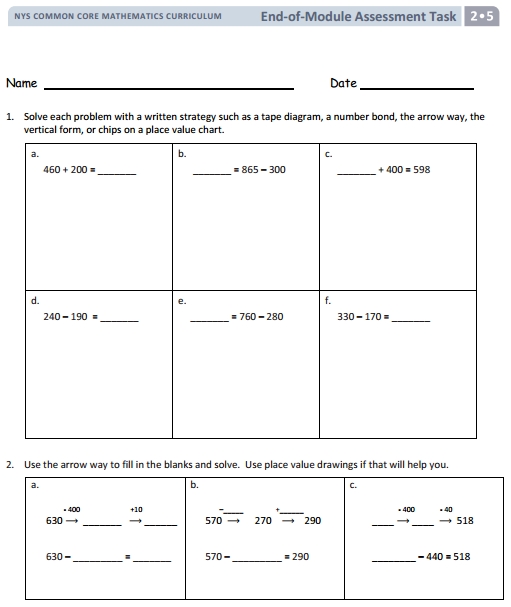Grades 1 and 2 Full Mathematics Curriculum
This is the Mathematics Curriculum for Grades 1 and 2 for New York Common Core. Grade 1 has six Modules and grade 2 has eight. Each one contains Topics with multiple Lessons, and each lesson provides a Problem Set, Exit ticket, Homework and Sprint. Mid-module and end-of-module assessments, with answers, are included in each full module. Also available below are Answer keys for lesson Assessments, and folders with kessons in word format for Grade 1 and Grade 2 (for editing, if desired). If you’re interested you can also check out the kindergarten and grades 3 and 4 curricula of this math series.
Grade 1 Mathematics Curriculum
Update: Eureka Math has separated these 1st grade math modules into separate pdf topic files to make them easier to use, and they have also included a variety of supplementary materials, including videos. You can view and download everything in 1st Grade Eureka Math here.
Operations and Algebraic Thinking, Number and Operations in Base Ten, Measurement and Data.
Grade 1 – Math Module 1 (Answer keys) (Lesson docs for Module 1)
Sums and Differences to 10 – Students learn addition and subtraction of numbers to 10.
- Topic A: Embedded Numbers and Decompositions
- Topic B: Counting On from Embedded Numbers
- Topic C: Addition Word Problems
- Topic D: Strategies for Counting On
- Topic E: The Commutative Property of Addition and the Equal Sign
- Topic F: Development of Addition Fluency Within 10
- Topic G: Subtraction as an Unknown Addend Problem
- Topic H: Subtraction Word Problems
- Topic I: Decomposition Strategies for Subtraction
- Topic J: Development of Subtraction Fluency Within 10
Grade 1 – Math Module 2 (Answer keys) (Lesson docs for Module 2)
Introduction to Place Value Through Addition and Subtraction Within 20 – Students begin addition and subtraction problems involving teen numbers.
- Topic A: Counting On or Making Ten to Solve Result Unknown and Total Unknown Problems
- Topic B: Counting On or Taking from Ten to Solve Result Unknown and Total Unknown Problems
- Topic C: Strategies for Solving Change or Addend Unknown Problems
- Topic D: Varied Problems with Decompositions of Teen Numbers as 1 Ten and Some Ones
Grade 1 – Math Module 3 (Answer keys) (Lesson docs for Module 3)
Ordering and Comparing Length Measurements as Numbers – Students explore the usefulness of measuring with similar units.
- Topic A: Indirect Comparison in Length Measurement
- Topic B: Standard Length Units
- Topic C: Non-Standard and Standard Length Units
- Topic D: Data Interpretation
Grade 1 – Math Module 4 (Answer keys) (Lesson docs for Module 4)
Place Value, Comparison, Addition and Subtraction to 40 – Use place value to add, subtract, and compare.
- Topic A: Tens and Ones
- Topic B: Comparison of Pairs of Two-Digit Numbers
- Topic C: Addition and Subtraction of Tens
- Topic D: Addition of Tens or Ones to a Two-Digit Number
- Topic E: Varied Problem Types Within 20
- Topic F: Addition of Tens and Ones to a Two-Digit Number
Grade 1 – Math Module 5 (Answer keys) (Lesson docs for Module 5)
Identifying, Composing, and Partitioning Shapes – Students consider part–whole relationships through a geometric lens.
- Topic A: Attributes of Shapes
- Topic B: Part–Whole Relationships Within Composite Shapes
- Topic C: Halves and Quarters of Rectangles and Circles
- Topic D: Application of Halves to Tell Time
Grade 1 – Math Module 6 (Answer keys) (Lesson docs for Module 6)
Place Value, Comparison, Addition and Subtraction to 100 – Students extend their understanding of tens and ones, to add and subtract within 100.
- Topic A: Comparison Word Problems
- Topic B: Numbers to 120
- Topic C: Addition to 100 Using Place Value Understanding
- Topic D: Varied Place Value Strategies for Addition to 100
- Topic E: Coins and Their Values
- Topic F: Varied Problem Types Within 20
- Topic G: Culminating Experiences
Grade 2 Mathematics Curriculum
Update: Eureka Math has separated these 2nd grade math modules into separate pdf topic files to make them easier to use, and they have also included a variety of supplementary materials, including videos. You can view and download everything in 2nd Grade Eureka Math here.
Students extend understanding of base-ten notation, fluency with addition and subtraction, standard units of measure, and describing and analyzing shapes.
Grade 2 – Math Module 1 (Answer keys) (Lesson docs for Module 1)
Sums and Differences to 20 – Students practice the new required fluencies. Students also represent and solve word problems using addition and subtraction
- Topic A: Foundations for Addition and Subtraction Within 20
- Topic B: Mental Strategies for Addition and Subtraction Within 20
- Topic C: Strategies for Addition and Subtraction Within 100
Grade 2 – Math Module 2 (Answer keys) (Lesson docs for Module 2)
Addition and Subtraction of Length Units – Students measure, estimate, and solve word problems involving addition and subtraction of length.
- Topic A: Understand Concepts About the Ruler
- Topic B: Measure and Estimate Length Using Different Measurement Tools
- Topic C: Measure and Compare Lengths Using Different Length Units
- Topic D: Relate Addition and Subtraction to Length
Grade 2 – Math Module 3 (Answer keys) (Lesson docs for Module 3)
Place Value, Counting, and Comparison of Numbers to 1,000 – Students work with metric units, i.e. centimeters and meters, to support upcoming work with place value concepts.
- Topic A: Forming Base Ten Units of Ten, a Hundred, and a Thousand
- Topic B: Understanding Place Value Units of One, Ten, and a Hundred
- Topic C: Three-Digit Numbers in Unit, Standard, Expanded, and Word Forms
- Topic D: Modeling Base Ten Numbers Within 1,000 with Money
- Topic E: Modeling Numbers Within 1,000 with Place Value Disks
- Topic F: Comparing Two Three-Digit Numbers
- Topic G: Finding 1, 10, and 100 More or Less Than a Number
Grade 2 – Math Module 4 (Answer keys) (Lesson docs for Module 4)
Addition and Subtraction Within 200 with Word Problems to 100 – Students add and subtract within 200 to deepen understanding of base-ten, place value, and properties of operations.
- Topic A: Sums and Differences Within 100
- Topic B: Strategies for Composing a Ten
- Topic C: Strategies for Decomposing a Ten
- Topic D: Strategies for Composing Tens and Hundreds
- Topic E: Strategies for Decomposing Tens and Hundreds
- Topic F: Student Explanations of Written Methods
Grade 2 – Math Module 5 (Answer keys) (Lesson docs for Module 5)
Addition and Subtraction Within 1,000 with Word Problems to 100 – Students extend conceptual understanding of addition and subtraction algorithms to numbers within 1000.
- Topic A: Strategies for Adding and Subtracting Within 1,000
- Topic B: Strategies for Composing Tens and Hundreds Within 1,000
- Topic C: Strategies for Decomposing Tens and Hundreds Within 1,000
- Topic D: Student Explanations for Choice of Solution Methods
Grade 2 – Math Module 6 (Answer keys) (Lesson docs for Module 6)
Foundations of Multiplication and Division – Students extend understanding of a unit to build the foundation for multiplication and division wherein any number can be a unit.
- Topic A: Formation of Equal Groups
- Topic B: Arrays and Equal Groups
- Topic C: Rectangular Arrays as a Foundation for Multiplication and Division
- Topic D: The Meaning of Even and Odd Numbers
Grade 2 – Math Module 7 (Answer keys) (Lesson docs for Module 7)
Problem Solving with Length, Money, and Data – Students learn to work with various types of units within the contexts of length, money, and data.
- Topic A: Problem Solving with Categorical Data
- Topic B: Problem Solving with Coins and Bills
- Topic C: Creating an Inch Ruler
- Topic D: Measuring and Estimating Length Using Customary and Metric Units
- Topic E: Problem Solving with Customary and Metric Units
- Topic F: Displaying Measurement Data
Grade 2 – Math Module 8 (Answer keys) (Lesson docs for Module 8)
Time, Shapes, and Fractions as Equal Parts of Shapes – Students investigate, describe, and reason about the composition and decomposition of shapes to form other shapes.
- Topic A: Attributes of Geometric Shapes
- Topic B: Composite Shapes and Fraction Concepts
- Topic C: Halves, Thirds, and Fourths of Circles and Rectangles
- Topic D: Application of Fractions to Tell Time
-love learning -your best ed lessons guide, Scott





This is my first time pay a quick visit at here and i am really impressed to read everything at alone place.
Very timely and interesting lesson content for early math and arithmetic. Thank you for posting this.